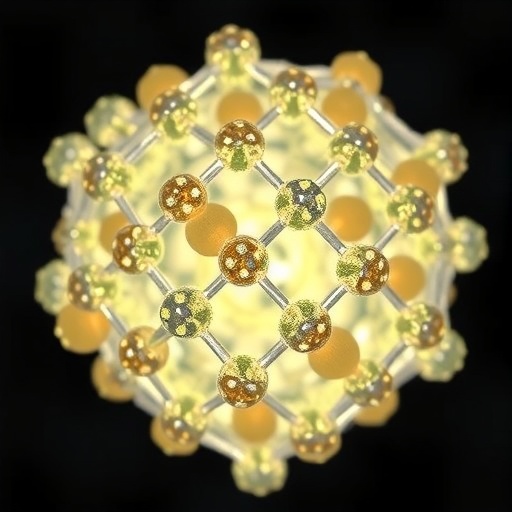In recent years, the quest for efficient photocatalysts has garnered significant attention in the realm of materials science and environmental remediation. Among various photocatalytic materials, α-Bi2O3 has emerged as a notable contender due to its unique structural and optical properties. The latest research by Kombaiah and colleagues dives deep into enhancing the photocatalytic efficiency of α-Bi2O3 through the impregnation of nickel ions (Ni2+). This innovative approach promises to unlock new potentials in the treatment of organic pollutants, particularly methylene blue dye, a common contaminant found in textiles and other industries.
The impregnation of metal ions onto semiconductor materials aims to improve their electronic properties, which can significantly influence their photocatalytic performance. Specifically, the introduction of Ni2+ ions into the α-Bi2O3 matrix modifies both structural and electronic configurations. This enhances charge separation and transport, which plays a critical role in effective photocatalytic activity. Such modifications are crucial in catalyzing the degradation of organic dyes, which are notoriously resistant to conventional treatment processes.
The structural characterization of the Ni2+-impregnated α-Bi2O3 was meticulously performed using advanced techniques. X-ray diffraction (XRD) analyses indicated that the crystalline structure of the host material is maintained even after the metal ion impregnation. This stability ensures that α-Bi2O3 retains its beneficial properties while simultaneously incorporating the catalytic benefits provided by the nickel ions. The structural integrity of the material is pivotal for its performance and longevity in photocatalytic applications.
Further morphological examination using scanning electron microscopy (SEM) demonstrated a change in particle size and distribution upon Ni2+ impregnation. The modifications observed in the surface morphology are significant as they influence the available surface area for catalytic reactions. A larger surface area typically leads to increased interaction with light and pollutants, thereby enhancing the photocatalytic degradation process. The enhanced surface characteristics facilitate higher adsorption rates of methylene blue dye, which is essential for effective photocatalytic activity.
Optical properties also play a vital role in determining the effectiveness of photocatalysts. Photoluminescence spectroscopy (PL) measurements indicated that the incorporation of Ni2+ ions improved the optical absorption properties of α-Bi2O3. This enhancement is crucial as it allows for increased light absorption in the visible spectrum, making the photocatalyst more effective under solar illumination. The ability to harness sunlight for degradation processes represents a crucial step toward sustainable and eco-friendly wastewater treatment solutions.
The photocatalytic performance of the Ni2+-impregnated α-Bi2O3 was rigorously tested against methylene blue dye under various conditions. Notably, the optimized conditions include controlling the pH and the concentration of the dye solution. The findings highlighted a marked improvement in degradation rates compared to pure α-Bi2O3. Such findings not only underscore the effectiveness of nickel ion impregnation but also contribute to a more profound understanding of the operational parameters that influence photocatalytic processes.
The kinetics of photocatalytic degradation were further investigated, revealing that the reaction follows first-order kinetics. This indicates that the rate of degradation is directly proportional to the concentration of methylene blue dye in the solution. Such insights are fundamental for scaling up the treatment process in real-world applications, providing a pathway to design more effective environmental remediation strategies using these advanced materials.
Additionally, the stability and reusability of the Ni2+-impregnated α-Bi2O3 were explored to assess its potential for practical applications. The catalyst maintained high activity levels across multiple cycles, demonstrating that it could be an effective and sustainable solution for wastewater treatment. Such reusability is vital for industrial applications, where the longevity of the photocatalyst directly correlates with economic viability.
The implications of this research extend beyond mere academic interest; they present real-world solutions to pressing environmental issues. Methylene blue dye represents just one of many organic pollutants in industrial effluents. The methodologies explored in this study could be applied to other contaminants, potentially revolutionizing how industries manage their waste streams. The flexibility of modifying the photocatalytic materials allows for tailored approaches depending on the specific pollutants present in wastewater.
In conclusion, the innovative contributions of Kombaiah and his colleagues highlight the transformative potential of metal ion impregnation in enhancing the photocatalytic properties of α-Bi2O3. As the world continues to grapple with environmental challenges posed by industrial pollutants, such advancements could pave the way toward cleaner, more sustainable practices across multiple industries. This study not only contributes to the scientific community’s understanding of photocatalytic processes but also sets the stage for future advancements in material science focused on environmental applications.
As researchers continue to explore the boundaries of photocatalytic efficiency, the findings from this study will undoubtedly inspire further innovations in the design and application of advanced materials for environmental remediation. The incorporation of Ni2+ in α-Bi2O3 may be just the beginning of a new era in sustainable technology where the fusion of materials science and environmental engineering leads to impactful solutions.
Subject of Research: Photocatalytic efficiency of Ni2+-impregnated α-Bi2O3 for methylene blue dye degradation.
Article Title: Impregnation of Ni2+ on α-Bi2O3 for their structural, morphological, optical, and photocatalytic efficiency on methylene blue dye.
Article References: Kombaiah, K., Kannan, P., Vijaya, J.J. et al. Impregnation of Ni2+ on α-Bi2O3 for their structural, morphological, optical, and photocatalytic efficiency on methylene blue dye. Ionics (2025). https://doi.org/10.1007/s11581-025-06735-x
Image Credits: AI Generated
DOI: https://doi.org/10.1007/s11581-025-06735-x
Keywords: photocatalysis, α-Bi2O3, Ni2+ impregnation, methylene blue, environmental remediation.
Tags: advanced photocatalytic materialscharge separation in photocatalysisenvironmental remediation materialsmaterials science innovationsmethylene blue dye treatmentNi2+ ion impregnationorganic pollutant degradationphotocatalytic efficiency improvementsemiconductor electronic propertiesstructural characterization techniquesX-ray diffraction analysisα-Bi2O3 photocatalyst enhancement





